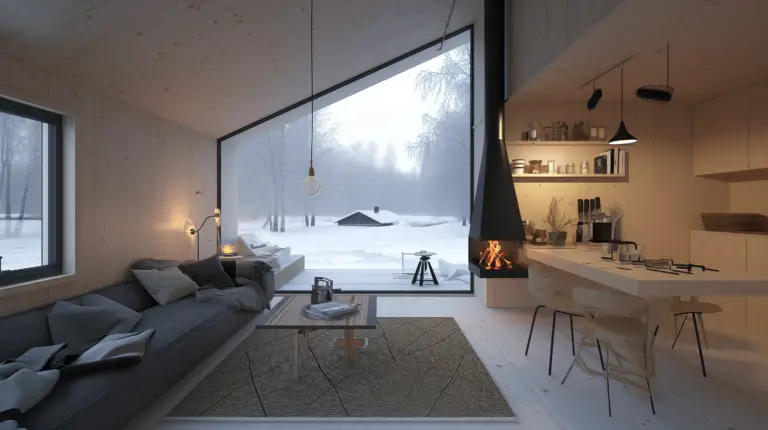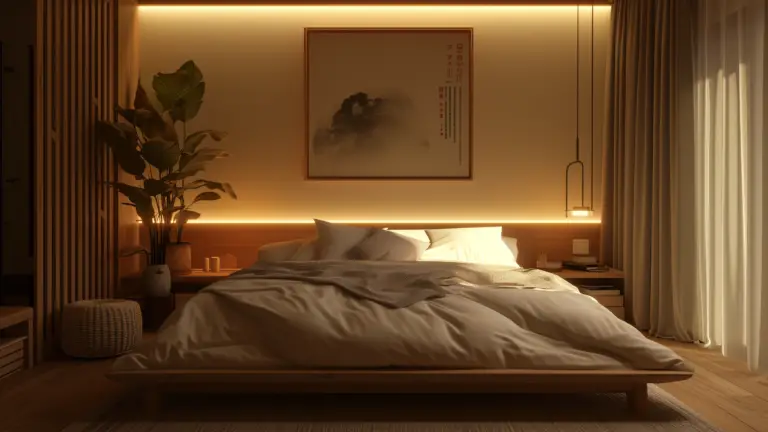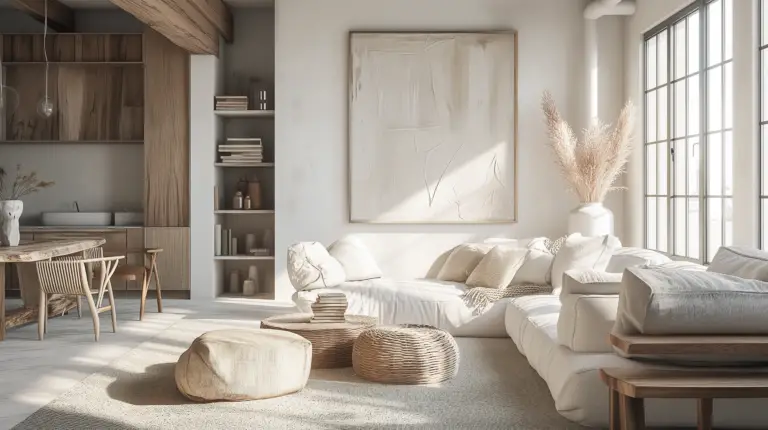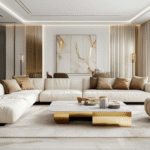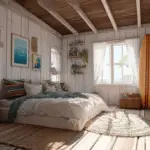Free Shipping On All Orders
15 Scandinavian Interior Design 2024 You Will Love
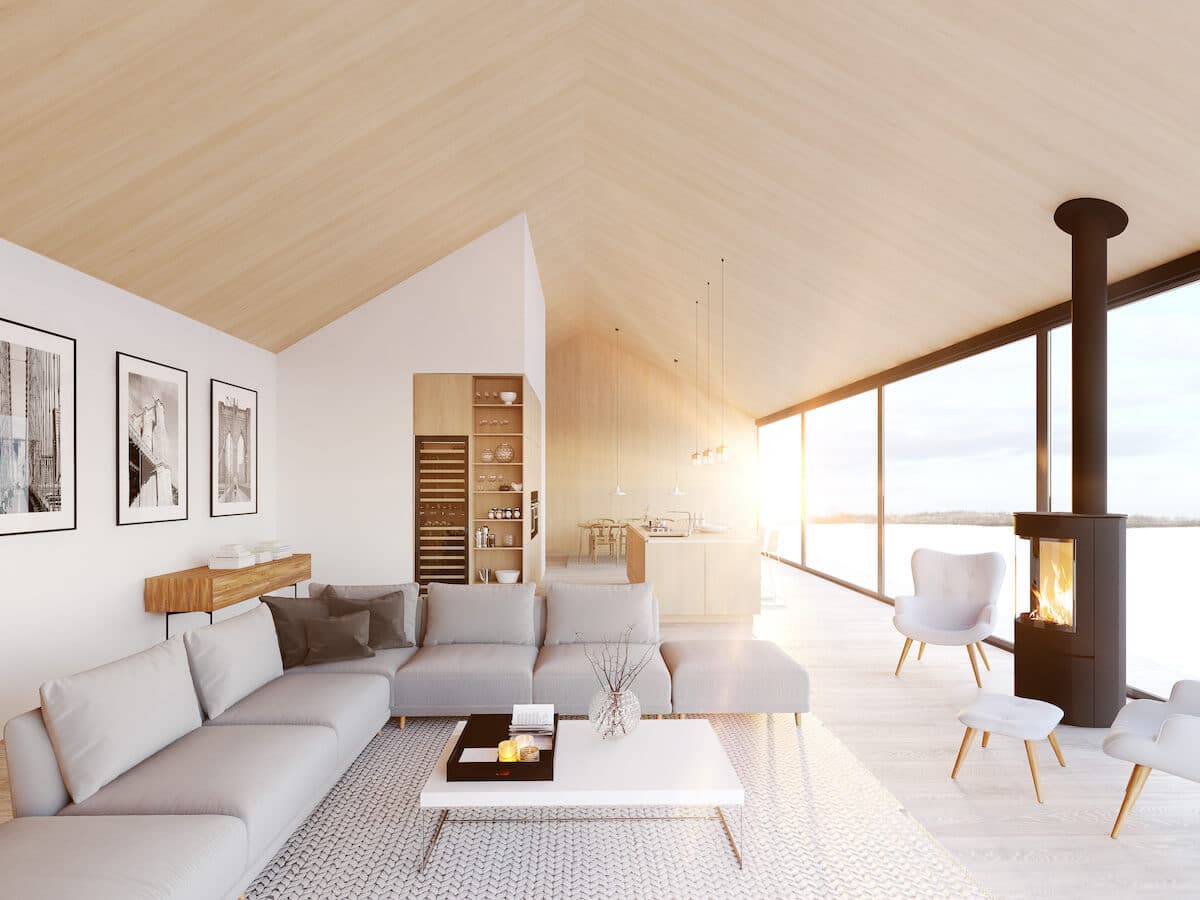
Scandinavian interior design, originating in the 20th century, has become one of the most popular design styles in America today. With a focus on simplicity, coziness, and functionality, this design philosophy blends natural elements, clean lines, and a minimalist color palette to create harmonious living spaces. Rooted in the belief that great design should be accessible to everyone, the Scandinavian style has been embraced by homeowners and designers alike.
One of the defining characteristics of Scandinavian design is its emphasis on natural light, a crucial aspect in Nordic regions with long, dark winters. The integration of cozy accents, striking modern furniture, and thoughtful use of textures contributes to the warm and inviting atmosphere typical of this design style. Whether applied to a city condo or a country home, Scandinavian interior design adapts beautifully to different settings, striking a balance between aesthetics and practicality.
Key Takeaways
- Scandinavian interior design emphasizes simplicity, functionality, and coziness through a minimalist color palette and natural elements.
- Incorporating natural light, modern furniture, and cozy accents creates a warm and inviting atmosphere in various living spaces.
- Originating in Nordic regions, the design philosophy aims to make great design accessible for everyone, striking a balance between aesthetics and practicality.
Fundamentals of Scandinavian Interior Design
Scandinavian interior design is known for its emphasis on minimalism, functionality, and simplicity. It creates a balance of aesthetics and coziness, often incorporating elements of nature into the design. The popularity of this design style can be attributed to its clean lines, neutral colors, and the warm atmosphere it brings to any space.
One of the key aspects of Scandinavian design is its focus on minimalism. This means decluttered spaces, with fewer but more meaningful items. In these interiors, every piece serves a purpose, ensuring that the area remains functional and comfortable. Maintaining a minimalist approach also creates a sense of spaciousness and allows natural objects to shine in the space.
Simplicity is another hallmark of Scandinavian interior design. Shapes, colors, and materials are kept simple, with a strong emphasis on clean lines and geometric forms. This design choice not only contributes to the overall aesthetic appeal, but it also makes the interiors easy to navigate and maintain.
The neutral color palette of Scandinavian design complements its minimal and simple nature. Typically, whites, grays, and muted earth tones are used to create a serene and calming environment. These color choices also accentuate the natural light coming into the space, making rooms appear larger and airier.
A key element of coziness in Scandinavian design is the concept of hygge. This Danish and Norwegian word refers to a sense of comfort, warmth, and contentment, often achieved through the use of soft textiles, warm lighting, and natural materials. By incorporating hygge, Scandinavian spaces feel welcoming, inviting, and enjoyable to the occupants.
Functionality is at the forefront of every Scandinavian design decision. Furniture pieces are chosen for their practicality as much as their form. Storage solutions like wall shelves, built-in cabinets, and hidden compartments help to maintain a clean and organized space. Moreover, multifunctional pieces, like sofa beds or storage ottomans, are often used to make the most of the available space.
To create a strong connection to nature, Scandinavian design incorporates natural materials like wood, leather, and wool. Wooden floors, for example, are a common feature in these interiors, as they imbue warmth and texture to a room. Additionally, the use of plants and green accents help bring the outdoors in, reinforcing the connection to the natural world.
In summary, the fundamentals of Scandinavian interior design can be best described by its minimalist, simple, and functional approach, combined with a cozy and nature-inspired atmosphere. By incorporating these key elements, this design style creates visually appealing and comfortable spaces, perfect for modern living.
Color Palette and Materials

The Scandinavian interior design is known for its simplicity, minimalism, and functionality. A significant aspect of this design style is the use of a neutral color palette and natural materials. The color choices and materials utilized in Scandinavian design are inspired by the wintery landscape and skies of the Nordic countries.
Whites, grays, black, and blue accents are the typical colors you will find in a Scandinavian interior. These colors create a soothing and calming atmosphere, while also enhancing the sense of light and airiness in a space. White is often used as a base color, while gray and black are added for contrast and depth. Blue accents bring an unexpected pop of color, reminiscent of the Nordic skies.
Natural materials play a crucial role in Scandinavian design, adding warmth and texture to the neutral colors. Wood is the most common material used, seen in flooring, furniture, and decorative accessories. Light-colored woods, such as oak and ash, are preferred for their ability to add warmth without darkening the space. Other natural materials, such as stone, cotton, and wool, are also frequently used in Scandinavian interiors, providing both functionality and aesthetics.
Incorporating natural elements and a neutral color palette in your Scandinavian-inspired space will not only enhance its visual appeal, but also create a sense of calmness, tranquility, and connection to the environment. Remember to keep it simple, minimalistic, and functional, which are the core principles of Scandinavian design.
Incorporating Natural Elements

Scandinavian interior design greatly emphasizes the use of natural elements in its aesthetic. This approach not only adds a touch of warmth and coziness to the living space but also promotes a connection with nature. Here, we will discuss how to incorporate these elements into your interiors effectively.
Wood is a vital component of Scandinavian design. It is widely used for flooring, furniture, and even wall coverings. Opting for light-colored woods, such as oak, beech, or ash, can brighten up the space and provide a sense of calm and airiness. Consider incorporating natural wood furniture, such as a wooden dining table or a bookshelf, to add warmth and texture to your room.
One of the key aspects of this design style is the integration of nature in the form of plants and greenery. Adding potted plants or a stunning indoor vertical garden can instantly uplift the atmosphere of your space. You may want to choose low-maintenance plants that can thrive in lower light conditions, such as snake plants, pothos, or ferns.
Artwork inspired by nature is another popular way to introduce natural elements into Scandinavian interiors. Selecting prints, paintings, or photographs that showcase landscapes, animals, or abstract representations of nature can complement the minimalist aesthetic of the room while adding visual interest.
One crucial aspect in the Scandinavian design is natural light. To bring more sunlight into the space, keep window treatments minimal and avoid heavy curtains or blinds. Placing mirrors strategically across windows can also encourage increased light distribution throughout the room, thus creating a bright and airy atmosphere.
The use of natural colors is essential in achieving a harmonious Scandinavian interior design. Incorporating soft, earthy hues like beige, light gray, and muted greens can create a comfortable yet sophisticated ambiance. To make the space more vibrant, consider adding accent pillows or throws in bolder colors like rich burgundy or deep blue.
Incorporating natural elements into your Scandinavian interior design can create a serene environment filled with warmth and harmony. By focusing on wood, nature, plants, artwork, natural light, greenery, natural colors, and natural wood, your living space will exude the essence of Scandinavian minimalism and tranquility.
Furniture and Accessories

Scandinavian interior design is known for its minimalism and functionality, incorporating elements of simplicity, natural materials and clean lines. Furniture in this style often features wooden elements, from light to dark tones, adding warmth and a connection to nature. IKEA is a highly popular brand worldwide that offers a wide range of Scandinavian-inspired furniture at affordable prices.
Modern furniture, both new and vintage, plays a significant role in Scandinavian style interiors. Keep an eye out for pieces with sleek designs, gentle curves, and an overall sense of harmony. Some popular materials to consider include teak, oak, and pine. Online retailers like Nordic Nest offer a vast selection of Scandinavian design elements for every room in your home.
When it comes to accessories, less is more in Scandinavian interior design. Instead of cluttering spaces with numerous items, focus on a few thoughtfully chosen pieces that serve a purpose and enhance the overall aesthetic. Textiles like rugs, cushions, and throws in soft colors or simple patterns can add texture and warmth to a space. Etsy is a great place to discover unique, handmade Scandinavian furniture and decor items.
Here are some common accessory options for a Scandinavian-inspired space:
- Soft lighting from floor lamps or pendant lights
- Simple, clean-lined wall art or prints
- Natural materials like wood, ceramics, and linen
- Plants to bring a touch of nature indoors
Find a balance between having a cozy, inviting atmosphere and maintaining a sense of spaciousness and simplicity. Remember, the key to achieving a truly Scandinavian-style interior lies in its confident, knowledgeable, neutral and, above all, clear approach to design and functionality.
Textiles and Textures

Textiles and textures play a crucial role in Scandinavian interior design, adding warmth and coziness to the otherwise minimal and clean aesthetic. Wool, leather, and various kinds of fabrics are commonly used in this style, helping create visual interest and comfort.
One popular aspect of Scandinavian textiles is the use of bold patterns, often inspired by nature, that introduce a dynamic touch to an otherwise simple space. Geometric patterns featuring clean lines and angular shapes blend harmoniously with the overall design theme, adding a sense of energy while not overpowering the room.
Scandinavian design is also known for its emphasis on natural materials, which is why wool, leather, and animal skins are often found in these interiors. Woolen throws and blankets, for example, add both textural and visual interest while providing warmth and insulation during the colder months. Leather furniture, like chairs or sofas, offers a sleek touch that contrasts beautifully with the organic textures found in other elements of the room.
Throw pillows are another essential part of Scandinavian interior spaces, bringing in additional layers of texture and comfort. They often utilize fabrics with tactile patterns or are adorned with creative designs that reflect Nordic culture and storytelling. These pillows help soften the look of sleek, minimalist furniture and contribute to the overall welcoming atmosphere of the space.
Animal skins and pelts serve as luxurious accents that further enrich the Scandinavian design experience. They can be used as decorative and functional elements, such as draping over furniture or as area rugs on the floor. These natural textures not only elevate the interior ambiance but also honor the regional tradition of using locally sourced materials.
In conclusion, textiles and textures are indispensable components of Scandinavian interior design. They provide an essential balance between the minimalist aesthetic and the desire for comfort and warmth, elevating the space and creating harmonious, inviting interiors.
Lighting and Atmosphere

Scandinavian interior design is well-known for its emphasis on light, brightness, and coziness. The primary goal is to create a warm and inviting atmosphere that promotes relaxation and a sense of calm. To achieve this, Scandinavian designers employ various lighting techniques and strategies that are both functional and aesthetically pleasing.
One of the key aspects of Scandinavian lighting is focused on creating a sense of warmth. This is often achieved by using an array of light sources, ranging from floor lamps to table lamps to pendant lamps, that emit a warm and diffuse light. The soft, inviting glow mimics the feel of candlelight, which is a crucial component of the Scandinavian interior. In fact, candles are frequently used as decorative elements in Scandinavian homes, enhancing the cozy and intimate atmosphere they’re known for.
To further accentuate the warmth and coziness, Scandinavian designers incorporate calming, light colors in their interiors. By utilizing a palette composed of whites, grays, and other soft, muted tones, the spaces maintain a sense of bright airiness. This enhances the natural light that floods into the rooms, contributing to the overall atmosphere of comfort and tranquility.
In addition to light colors, Scandinavian interiors often feature contrast between different materials and textures. A combination of warm wood tones and smooth, polished surfaces can create a sense of depth and interest within the space. This balance between various elements helps establish a harmonious and visually appealing design.
Ultimately, the Scandinavian approach to lighting and atmosphere prioritizes comfort, wellbeing, and a connection to nature. By thoughtfully combining these elements, designers can create interiors that exude a sense of calm, bright, and cozy living.
Scandinavian Interior Details

Scandinavian interior design is renowned for its minimalism, simplicity, and functionality. Key elements of this design style include natural light, clean lines, and light wood flooring. In this section, we’ll explore the various elements of Scandinavian interior design in living rooms, kitchens, and other spaces, achieving an elegant and inviting atmosphere throughout the home.
Light wood flooring is a staple of Scandinavian interiors, emphasizing warmth and organic beauty. Opting for hardwoods such as oak, ash, or birch adds a light and airy touch to any room while providing durability for daily wear and tear. Complementing this flooring are simple furnishings, often made of similar wood tones or in sleek white, black, or gray hues. These furnishings help create an uncluttered, yet inviting atmosphere that embodies the essence of Scandinavian design.
Scandinavian living rooms prioritize comfort and coziness while maintaining a minimalistic aesthetic. Sofas and chairs with clean lines and neutral colors are often paired with cozy textiles like throws and cushions, incorporating soft textures to contrast the sleek furnishings. Natural light is an essential element, with large windows allowing sunlight to flood the space, enhancing the overall ambiance. In addition to this, lighting fixtures in Nordic design tend to be understated and functional, often featuring simple geometric shapes or sculptural elements that contribute to the room’s visual interest.
In Scandinavian kitchens, the same principles of simplicity and elegance apply. Cabinets with flat-panel or minimalistic designs are commonly found, as well as open shelving for easy access and a more expansive feel. Contrasting the white or light-colored cabinetry, countertops often showcase natural materials like wood or stone, adding to the organic character of the design. In order to maintain a clutter-free environment, efficient storage solutions and well-organized drawers are critical components, ensuring that all kitchen essentials have their designated place.
Throughout a Scandinavian interior, the use of natural elements and organic accents, such as indoor plants or woven textiles, adds an earthy touch that ties the space together. This harmonious blend of simplicity, elegance, and natural elements creates a soothing and comfortable atmosphere, ideal for both relaxation and socializing.
Design Tips for Budget and Function

Creating a Scandinavian interior doesn’t have to be expensive. By focusing on budget-friendly tips and the core principles of minimalism, you can achieve a stylish and functional space. Here are some design tips to help you create a Scandinavian-inspired interior on a budget.
Less is more: With a minimalist approach to Scandinavian design, you can save money by reducing the number of decorative items and furniture pieces. Stick to essential items and choose items that serve multiple purposes. This not only helps create a clean, uncluttered look but also frees up your budget for other areas.
Harmony: Achieving harmony in your space is crucial for both aesthetic and functional reasons. Ensure all elements of your room complement each other and contribute to a cohesive design. Choosing similar tones for furniture, textiles, and accessories allows you to create a unified and calming environment without spending much.
Utility: A vital principle in Scandinavian decor is form and function. When selecting items for your space, consider their practical uses in addition to their design. Opt for furniture with additional storage, and choose versatile pieces that can serve various functions. This approach will help you make the most of your budget and space.
Empty space and negative space: Embrace empty or negative space as an essential component in your design. It not only creates a sense of spaciousness but also reduces the need for multiple items. By allowing space to breathe, you’ll enhance the overall aesthetic without breaking the bank.
Ultimately, achieving a Scandinavian interior on a budget comes down to focusing on key design principles. Adopt a minimalist approach, ensure harmony, prioritize utility, and embrace empty space to create a beautiful, functional space that won’t break the bank.
Influence of Nordic Regions

The Nordic regions, consisting of Denmark, Sweden, Norway, and Finland, have had a significant impact on the development and popularity of Scandinavian interior design. This unique style is characterized by a combination of clean lines, functional design, and a focus on natural materials and minimalism. Influences from various Nordic traditions contribute to the distinctiveness of this beloved design style.
Drawing inspiration from Nordic cities such as Stockholm and Copenhagen, Scandinavian design emphasizes the use of light colors and an abundance of natural light to create interiors that feel bright and inviting, even during the cold, dark winter months. This approach is a response to the region’s notoriously short days and harsh weather conditions, which are particularly challenging in countries like Norway and Finland.
Danish design is a key component of the broader Scandinavian design movement, and it often features a focus on craftsmanship and simplicity. The iconic Danish designer Arne Jacobsen once said: “The primary factor is proportions”; this is reflected in the way Danish-designed furniture and home accessories are carefully crafted to promote both comfort and harmony within a space.
Scandinavian colors tend to be subdued and neutral, with a preference for shades of white, gray, beige, and muted blues and greens. These colors create a calming atmosphere and serve as a timeless base for any interior design style. The use of natural materials such as wood, wool, and linen also contribute to the warm, inviting ambiance that Scandinavian interiors are known for.
Overall, the influence of the Nordic regions on Scandinavian interior design is evident in the style’s emphasis on functionality, simplicity, and connection to nature. By reflecting the values and lifestyle of these northern countries, Scandinavian design has become an enduring and globally admired approach to creating beautiful, comfortable living spaces.
Conclusion
Scandinavian interior design has become a popular choice for many homeowners due to its timeless beauty and simplicity. Rooted in the modernist movement, this design style carries an air of sophistication while maintaining a comfortable atmosphere.
The foundation of Scandinavian interior design is heavily influenced by the region’s climate, culture, and typography. One of the most distinctive aspects of this style is the use of natural wood in its furnishings and decoration. This not only adds warmth to the space but also enhances its elegance.
Opting for simple furnishings, minimalistic approach and geometric patterns, the Scandinavian style gives priority to functionality along with aesthetics. The choice of contemporary color schemes, like brown and muted tones with a mixture of bold accents, further contribute to the overall design.
Additionally, raw textures play an essential role, with elements such as sheepskin rugs, handmade textiles, and other vintage-inspired décor items sourced from Scandinavian countries like Stockholm, Norway, and Denmark. Incorporating prominent brands like IKEA, Scandinavian design is attainable for almost everyone.
In conclusion, Scandinavian interior design is a timeless, versatile, and tasteful option for homeowners looking to create a welcoming and visually appealing space. It combines elegance and functionality with subtle sophistication, making it an enduring favorite among design enthusiasts.
Frequently Asked Questions
What is Scandinavian interior design?
Scandinavian interior design is a style that emerged in the 20th century and focuses on simplicity, coziness, and functionality. It is characterized by clean lines, neutral colors, and natural materials.
How do I decorate my home in Scandinavian style?
To decorate your home in Scandinavian style, focus on simplicity,
functionality, and coziness. Use neutral colors, natural materials, and clean lines. Add texture with cozy blankets and rugs, and incorporate natural elements like plants and wood.
What are some key elements of
Scandinavian interior design?
Key elements of Scandinavian interior design include clean lines, neutral colors, natural materials, and functional furniture. Other important aspects include coziness, simplicity, and a focus on light and space.
If you liked this post about Scandinavian interior design, don’t forget to follow us on Pinterest so you don’t miss any more interior design news!


